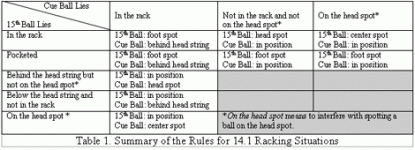Dennis, after rereading 4.8(d) carefully it seems to me the cue ball would only go on the center spot if the OB is BOTH in the kitchen AND interferes with placing the cue ball on the head spot.
Pay particular attention to the punctuation:
There are two conditions discussed - the first where the OB is not in the kitchen and the second where the OB is in the kitchen. Notice that the first condition, where the OB is in front of the head string, is separated from the rest of the sentence by a semicolon. Everything after the semicolon (the part about the object ball in the kitchen and treatment if it is in the head spot area) goes together as only commas are used. So the part about CB center spot placement only applies to the 2nd condition of the OB being behind the head string, at least the way I read it.
The text has to override the chart since it is the more detailed explanation of the rule. The chart is simply there for reference purposes, a cheat sheet if you will.
interesting, Dennis; so it depends upon which part of section 4.8 you follow.
the chart contradicts the procedural logic stated in the textual rules above. further, it would over-ride 4.8(d) even for a ball that was clearly Forward of the head string if (and Only if) that ball also overlaps the spot. and "overlaps the spot" is defined by the shadow of a ball placed on the spot, meaning a ball more than an inch forward of the line could be ineligible to shoot from behind the line. bizarre.
so if the chart which clarifies the rules above instead conflicts with them, which takes precedence?
Cheat sheets promulgated by the same entity that promulgates the rules are meant to make things easier to understand and I think they are used to interpret and explain the rules, so I think the chart and definition would have to control.
I think it depends upon how we define a ball that is "on the head spot".
If we say that if it is on the head spot, then it is on the head string, then the cue ball would go behind the head string.
However, if we say that a ball on the head string is by definition, a ball that is interfering with spotting a ball on the head spot, then the cue ball would go on the middle spot.
There is a certain harmony to the solution if we view it this way. After all, we do know that if it were the other way around, i.e. the object ball in the rack and the cue ball on the head spot, there would be no question but that the object ball goes to the center spot.
Plus to believe otherwise, we would have to think that all of the people that have taken the time to read the rules and to carry around the chart with them in order to properly know how to rack the balls, have been misled by the WPA.
I believe that Bob Jewett should weigh in as he is part of the panel that promulgated the rules. If I am wrong, I want to be corrected so that I do not spread the wrong information around.
